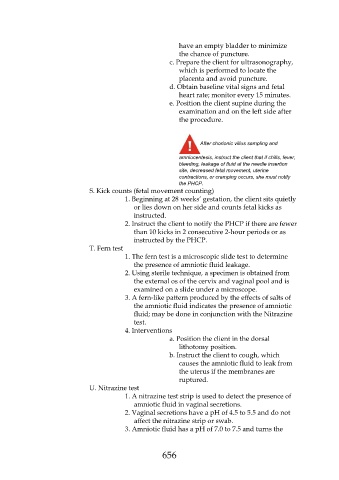Page 656 - Saunders Comprehensive Review For NCLEX-RN
P. 656
have an empty bladder to minimize
the chance of puncture.
c. Prepare the client for ultrasonography,
which is performed to locate the
placenta and avoid puncture.
d. Obtain baseline vital signs and fetal
heart rate; monitor every 15 minutes.
e. Position the client supine during the
examination and on the left side after
the procedure.
After chorionic villus sampling and
amniocentesis, instruct the client that if chills, fever,
bleeding, leakage of fluid at the needle insertion
site, decreased fetal movement, uterine
contractions, or cramping occurs, she must notify
the PHCP.
S. Kick counts (fetal movement counting)
1. Beginning at 28 weeks’ gestation, the client sits quietly
or lies down on her side and counts fetal kicks as
instructed.
2. Instruct the client to notify the PHCP if there are fewer
than 10 kicks in 2 consecutive 2-hour periods or as
instructed by the PHCP.
T. Fern test
1. The fern test is a microscopic slide test to determine
the presence of amniotic fluid leakage.
2. Using sterile technique, a specimen is obtained from
the external os of the cervix and vaginal pool and is
examined on a slide under a microscope.
3. A fern-like pattern produced by the effects of salts of
the amniotic fluid indicates the presence of amniotic
fluid; may be done in conjunction with the Nitrazine
test.
4. Interventions
a. Position the client in the dorsal
lithotomy position.
b. Instruct the client to cough, which
causes the amniotic fluid to leak from
the uterus if the membranes are
ruptured.
U. Nitrazine test
1. A nitrazine test strip is used to detect the presence of
amniotic fluid in vaginal secretions.
2. Vaginal secretions have a pH of 4.5 to 5.5 and do not
affect the nitrazine strip or swab.
3. Amniotic fluid has a pH of 7.0 to 7.5 and turns the
656

